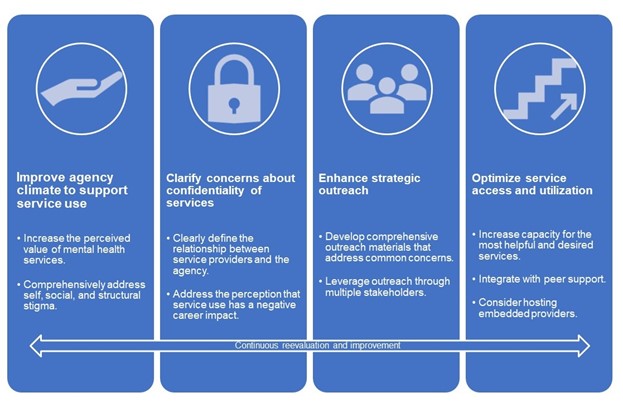First responders daily experience the effects of mental health injuries sustained on the job.1 In an environment where police officers, firefighters, and emergency medical technicians are at an elevated risk of dying by suicide, access to affordable and confidential mental health and wellness resources is critical.2 However, research has long suggested the utilization of wellness resources does not match the need for treatment.3
In North Carolina, the Department of Public Safety (NCDPS) has begun to answer the call to help those who help others. In 2020, NCDPS established a specialized, accessible, and completely confidential program for all employees of the department to access mental health and wellness services. Fast forward to 2024, and the North Carolina Responder Assistance Initiative (RAI) comprises a team of 20 dedicated professionals with a singular focus to reduce stigma and provide a foundation for wellness to the state’s public safety community.4 Housed within the North Carolina Division of Emergency Management, RAI seeks to become a gold standard program serving all first responders in the state, free of charge.
As explained by Emergency Management Director Will Ray,
North Carolina’s Responder Assistance Initiative is a new approach to ensuring that our public safety community has access to mental health resources that are tailored to their specific needs. These responders have sacrificed a lot in the name of public safety and continue to bear those scars. We are proud to continue our mission to build a system that provides high quality clinical treatment, reduces stigma, and provides the level of confidentiality necessary to ensure maximum participation.5
Historically, the most common strategy adopted by police agencies is the provision of stand-alone services (e.g., an employee assistance program, peer support, chaplaincy) detached from each other—rarely are these services integrated. Recognizing the disconnect and need for an integrated approach, RAI enhances current initiatives by unifying responder support systems.
RAI is made up of a mission-driven team of culturally adept licensed mental health professionals, professionally trained peers, and wellness coordinators who provide an integrated, comprehensive approach to police mental health and wellness tailored to the unique dynamics and concerns of public safety professionals. As a no-cost, confidential benefit to NCDPS employees, the broad range of services prepares officers and professional staff to manage work-related and personal stress; prevent repeated adverse reactions; and increase resilience, which leads to overall personal and career satisfaction, as well as agency success.
The continuum of services combines prevention and resilience strategies, gold standard peer support and leadership consultation, critical incident response, and trauma-informed behavioral health services. RAI strives to achieve programmatic impact through a collective effort with stakeholders, agencies, and professionals. All are committed to strengthening interagency trust and erasing turf lines to disrupt stigma and increase access to quality care. Additionally, RAI offers an embedded model of support that places providers and/or peers in designated sites to assimilate into specific settings in support of police employees. This approach fosters relationship building and tailored consistent support at times of need and throughout the employees’ career trajectories.
Evaluating RAI Service Utilization
To determine how to maximize the benefit of RAI to the public safety community, RAI partnered with RTI International (RTI), a nonprofit research institute, to conduct a mixed method, data-driven evaluation of the utilization of RAI services. The purpose was to gather information regarding the reach, scope, and perceived value of current RAI services to inform its ongoing program expansion.
RTI held focus groups and interviews to inform the development of a statewide web-based survey of staff in state police agencies, which were the primary focus of the evaluation. Five Department of Public Safety (DPS) agencies participated in the study: State Highway Patrol, State Bureau of Investigation, Alcohol Law Enforcement, State Capitol Police, and the Division of Juvenile Justice. The survey, administered in fall 2023, was completed by 1,759 sworn and professional DPS employees (representing 41 percent of agency staff).
Recommendations to Increase the Utilization of Mental Health and Well-Being Services
The evaluation identified several key programmatic, policy, and practice recommendations for police leadership, mental health providers, and peer support specialists who are working to develop, expand, and improve the accessibility of mental health resources within their agencies. The range of recommendations (shown in Figure 1) can be divided into the following broad issues: (1) improving agency climate to enhance the perceived value of services; (2) clarifying concerns regarding the confidentiality of services; (3) enhancing strategic outreach activities; and (4) optimizing service access and utilization.
| Figure 1: Recommendations for Enhancing Utilization of Mental Health and Wellbeing Services among Law Enforcement |
 |
1. Improve Agency Climate
Increase the perceived value of mental health services
To understand the perceived climate around mental health service utilization, respondents rated their agreement with statements related to the value of mental health services. Most respondents agreed that mental health and wellness services are valuable for law enforcement and public safety professionals (81 percent), and that mental health and wellness services are valuable for their personal well-being (74 percent).
Overall, when individuals perceived a higher value of mental health and well-being services, they indicated both higher intentions to seek out services and higher self-reported utilization of services. Specifically, for individuals who believed mental health and wellness services were important for themselves and for public safety professionals in general, there was a positive relationship with intentions to use mental health and wellness services for gaining preventative coping skills and addressing personal or professional challenges. In turn, these beliefs were also related to actual self-reported RAI service utilization. These findings suggest, particularly in agencies where staff indicate a lower overall perceived value of mental health services, it may also be useful to develop general awareness campaigns related to the benefits of mental health services for prevention and to address the chronic and acute stressors of public safety professionals.
Comprehensively address stigma
 To examine the possible influence of mental health stigma on engagement with services, respondents were asked to indicate their agreement with several statements assessing perception of different types of mental health stigma and the global perceptions of the influence of stigma as a barrier to seeking mental health and wellness services. Three dimensions of mental health stigma were considered, including
To examine the possible influence of mental health stigma on engagement with services, respondents were asked to indicate their agreement with several statements assessing perception of different types of mental health stigma and the global perceptions of the influence of stigma as a barrier to seeking mental health and wellness services. Three dimensions of mental health stigma were considered, including
-
- Self-stigma—the perception that seeking services implied a personal weakness or inability to perform police work effectively
- Social stigma— the perception that seeking services may cause the respondent to lose trust or standing with coworkers or supervisors
- Structural stigma—the perception that seeking services could impact future career opportunities
Overall, participants indicated lower levels of self-stigma than social stigma, with only 14.1 percent of respondents acknowledging self-stigma compared to 33.3 percent acknowledging social stigma. Notably, structural stigma was endorsed by a third of respondents (33.2 percent), highlighting the common belief that seeking services could have negative collateral consequences on professional opportunities. Broadly, almost half of respondents (48.7 percent) agree stigma in their profession creates a barrier to seeking mental health and wellness services. To reduce mental health stigma in agency settings, a three-pronged, strategic anti-stigma campaign focusing on self-, social, and structural mental health stigma is recommended. For example, highlighting the stories of employees and family members who have overcome personal or professional challenges by engaging with services can address both self- and social stigma, while reinforcing messages that individuals will not be disadvantaged professionally for seeking services can address concerns of structural stigma.
2. Clarify Concerns Regarding Confidentiality
Directly outline the relationship between the services offered and the agency
Close collaboration between service providers and police leadership may play a critical role in increasing the visibility of services offered and normalizing service engagement, particularly in terms of prevention. However, such partnerships should consider the context of significant stigma regarding mental health service utilization and the concerns of employees that using such services could have negative consequences on professional standing and work opportunities. For this reason, it is important to proactively communicate a wellness program or provider’s relationship with the agency in which it operates.
“Police leaders play a critical role in fostering a climate conducive to service utilization and investing in appropriate resources to maintain the health and stability of their agency’s workforce.”
While many programs put safeguards in place to protect officer privacy, potential service participants may be unaware of or not confident in these practices. Wellness providers should consider developing strategic resources and policy documentation transparently outlining how they work with partner agencies, which can be prominently featured in written communications, including websites and outreach materials (e.g., email announcements, flyers).
Additionally, service providers and peer support specialists should consider developing and implementing detailed internal protocols for ensuring interactions with agency staff to preempt confidentiality concerns. Such protocols could address logistical concerns such as the selection of private office space and ensuring intentional efforts to interact widely with agency staff (not just those seeking services).
Transparently address concerns about potential career impacts of using services
A critical aspect of ensuring police personnel feel comfortable accessing services is transparently addressing the perceived adverse professional consequences of seeking services. For this reason, agencies should develop and make accessible comprehensive mental health-related organizational policies that can directly address employees’ concerns about potential negative impacts of service use on their career (e.g., promotional opportunities, overtime eligibility, modified duty). Examples of such policies can be found on the International Association of Chiefs of Police (IACP) Policy Center website.6 If such policies are unavailable, officers are likely to assume the worst possible outcomes and avoid all services.7
3. Implement Strategic Outreach Activities
Develop comprehensive outreach materials that address common concerns
Despite the comprehensive scope of RAI services, many survey respondents were aware of only specific aspects of what the program offers. In general, clinical and peer services were the best-known category of all services, trailed by prevention, training, and consulting services. Moreover, there was variability among staff across the five agencies in terms of their knowledge about RAI-specific benefits.
These trends suggest a need to leverage comprehensive outreach materials to increase the understanding of the full scope of services and benefits offered. While in-person outreach efforts were seen as effective, it is also important to develop a comprehensive website overviewing an agency’s wellness programs to provide a clearinghouse for information about services offered and related information that addresses common client concerns (e.g., limits to confidentiality, agency-specific mental health policies). To facilitate trust building, websites should also provide detailed and personal introductions to program staff, providers, and affiliated peer support specialists.
Leverage outreach through multiple stakeholders
Outreach should leverage program staff, providers, peer support specialists, and agency leadership. Dissemination strategies should consider agency climate and preferred modes of outreach among different staff groups. Findings from the evaluation showed agency leadership is the most common way respondents heard about RAI; however, individuals who learned about the program from leadership also indicated lower levels of knowledge about the program details. Detailed reference and outreach materials should be provided to agency leadership to ensure they have comprehensive, informational materials readily available for dissemination. Finally, because more senior respondents’ knowledge of wellness programs was lower, it would be beneficial for information to be disseminated at regular intervals to all staff.
4. Optimize Service Access and Utilization
Increase capacity for the most helpful and desired services
Respondents widely agreed that RAI’s services are effective and helpful, while indicating clinical services (e.g., individual and couples counseling); peer support services (e.g., post-critical incident support); and prevention, training, and consulting services (e.g., Stress First Aid training) are of greatest appeal. Mental health providers and police leaders may wish to assess and prioritize service preferences based on the needs of agency employees to ensure limited resources are used most efficiently.
Integrate with peer support

A unique aspect of RAI is the integration of peer support specialists into the administration of its service offerings. The evaluation showed the integration contributes to greater knowledge about all available services (not just peer support services). Providers and police leaders may wish to explore a similar structure within their settings to the extent feasible. For example, if peer support is available, agency leadership may wish to expand and increase the presence of peer support specialists, while providers strategically leverage these individuals to promote awareness about the value of mental health and help link officers who could benefit from services to appropriate programs. In agencies where no peer support operates, agency leadership and providers should consider collaborating to support the development of peer support programs.
Consider hosting embedded providers
Results suggest a positive impact from embedding providers into agency settings, as indicated by improved familiarity with RAI services, enhanced knowledge of RAI benefits, and better perceptions of agency climate for mental health support. Embedding more providers into agency settings would likely improve outreach efforts, utilization rates, and perceived effectiveness of programs. There are, of course, many considerations impacting an agency’s ability to integrate providers into agency settings, such as resource constraints; the structures of each agency; and the unique responsibilities of specific workforces, which may predominantly place them in the field, not in offices. As such, it may not be feasible or useful to embed full-time providers. However, providers and agency leadership may be able to identify ways to host ad-hoc providers based on agency need (e.g., following a critical incident) and considering the unique structures of each agency.
Key Takeaways for Agency Leaders
The recommendations suggested by the evaluation of RAI are comprehensive, and additional analysis may be required to identify the most promising and suitable strategies for individual agencies, considering the benefits and cost effectiveness of each recommendation and given the structure and climate of the organization. Overall, respondents’ overwhelmingly positive perceptions of the services RAI offers suggest the holistic, integrated structure of RAI is beneficial to public safety personnel.
While there is growing recognition of the benefits of enhancing the mental health of police professionals through access to preventative and crisis response services, it can be challenging to determine what supports are necessary for a specific workforce and how to encourage the use of resources once they are in place. Regardless of where any agency is in its employee wellness journey, police leaders play a critical role in fostering a climate conducive to service utilization and investing in appropriate resources to maintain the health and stability of their agency’s workforce. While some of the preceding recommendations require significant financial investments (e.g., hiring embedded clinicians), there are several actions that require minimal resources and can be pursued today to make an immediate impact on an agency’s wellness strategies. These actions include the following:
-
- Ensure the agency’s policies related to mental health and well-being are comprehensive, detailed, and address common concerns staff may have regarding the impact of seeking mental health services.
- Take concerns around confidentiality seriously by directly and proactively communicating service providers’ relationships with the agency―and develop and implement detailed internal protocols for ensuring interactions with agency staff preempt confidentiality concerns.
- Encourage close collaboration between existing service providers and peer support specialists, if available. Close relationships between these two groups can ensure peer support specialists are familiar with the range of services available, suggest improvements based on their intimate understanding of the culture of the agency, and become champions for the services offered.
- Review and refine any existing outreach materials for mental health and well-being services to ensure they not only promote available services but also address concerns regarding confidentiality.
Final Thoughts
While the purpose of this evaluation was to examine the overall awareness about and utilization of a statewide continuum of mental health and wellness services among public safety professionals, it is critical that future evaluations of similar programs focus on health and wellness outcomes related to increased service utilization. It is hoped that this evaluation will generate interest and support from policymakers to support and expand much-needed efforts to improve police health and well-being. d
Notes:
1Elizabeth Velazquez and Maria Hernandez, “Effects of Police Officer Exposure to Traumatic Experiences and Recognizing the Stigma Associated with Police Officer Mental Health: A State-of-the-Art Review,” Policing: An International Journal 42, no. 4 (2019): 711–724; John M. Violanti et al., “Police Stressors and Health: A State-of-the-Art Review,” Policing: An International 40, no. 4 (2017): 642–656; William Berger et al., “Rescuers at Risk: A Systematic Review and Meta-Regression Analysis of the Worldwide Current Prevalence and Correlates of PTSD in Rescue Workers,” Social Psychiatry and Psychiatric Epidemiology 47 (2012): 1001–1011; Peter T. Haugen, Mark Evces, and Daniel S. Weiss, “Treating Posttraumatic Stress Disorder in First Responders: A Systematic Review,” Clinical Psychology Review 32, no. 5 (2012): 370–380.
2John M. Violanti et al., “Law Enforcement Suicide: A Review,” Policing: An International Journal 42, no. 2 (2018): 141–164; Ruderman Family Foundation, Ruderman White Paper on Mental Health and Suicide of First Responders (2018); Neil H. Vigil et al., “Death by Suicide—The EMS Profession Compared to the General Public,” Prehospital Emergency Care 23, no. 3 (2019): 340-345.
3Robert P. Delprino and Charles Bahn, “National Survey of the Extent and Nature of Psychological Services in Police Departments,” Professional Psychology: Research and Practice 19, no. 4 (1988): 421–425; George T. Patterson, “Reconceptualizing Traumatic Incidents Experienced by Law Enforcement Personnel,” Australasian Journal of Disaster and Trauma Studies (2001); Judith A. Waters and William Ussery, “Police Stress: History, Contributing Factors, Symptoms, and Interventions,” Policing: An International Journal 30, no. 2 (2007): 169–188.
4North Carolina Department of Public Safety, “Responder Assistance Initiative.”
5Will Ray (Emergency Management Director, NCDPS), email, January 22, 2023.
6 International Association of Chiefs of Police, “Employee Mental Health and Wellness.”
7Meret S. Hofer and Shannon M. Savell, “‘There Was No Plan in Place to Get Us Help’: Strategies for Improving Mental Health Service Utilization Among Law Enforcement,” Journal of Police and Criminal Psychology 36 (2021): 543–557.
Please cite as
Meret S. Hofer et al., “Integrating and Expanding Wellness Services : The North Carolina Responder Assistance Initiative,” Police Chief Online, May 22, 2024.



